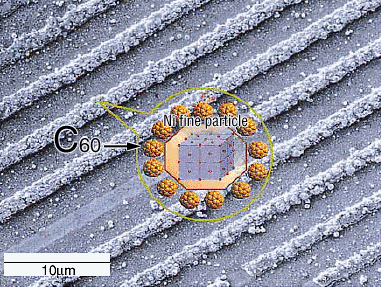In functional materials research the composing unit is getting smaller and spatially dense, and it has been recognized that artificial fine machining will come to the limit soon. As a possible breakthrough of overcoming the present barriers, the utilization of cooperative, spontaneous organization processes without any template (self-organization) is supposed to be promising. We have encountered a lucky chance to observe the beautifully arranged stripe structure with micron separation through the study of solid-state reactions between catalytic Ni and C60 (Fig. 1-11). A stripe is composed of many sub-micron-sized Ni fine particles covered with a polymerized C60 thin layer. The present structure can be realized only after the co-deposition of Ni and C60 at 450°C Basically Ni and C60 are immiscible and they have a tendency to segregate from each other, however, there exist small interactions associated with electron transfers from Ni to C60. When these competitive processes are operative at high temperature it will become possible to realize the self-organized structure as a subtly balanced state.
Now, we will take a close look at the details of the stripe structure. In our normal scientific approach, we will employ directed energy beams such as lasers and electron beams which correspond to our eye lines but the present stripe system is very sensitive to the energy deposition during structural analysis. So, the energy of the incident beams was finely controlled so as not to induce any chemical changes in the system. The position-sensitive element analysis was performed using Auger spectroscopy, and the position-dependent chemical bonding information was obtained with micro-Raman spectroscopy. The interpretation based on the above analysis is illustrated in Fig. 1-12. In this illustration the stripe pattern is depicted in a simple manner, however, one stripe is just like a set of linear chains of many fine Ni particles connected with each other. If we look below the stripe plane, there appears the layered structure composed of amorphous carbon and crystalline Ni layers. The Ni layer is formed selectively on MgO(100) substrate because of their chemical affinity.
Through these observations it can be understood that the super-saturated mixture between Ni and C60 can be transformed into a steady state at high temperature through the formation of a three-dimensional periodic structure as shown above.
The successful formation of a self-organized structure can be considered to be just the starting point for a further systematic approach exploring unknown phases with new functions originating from various critical states including the super-saturated state. Even in the stripe patterns of Fig. 1-11 at the primitive stage, possible applications are expected such as an optical grating device and/or a new type of memory utilizing the transportation feature between ferromagnetic Ni and the thin C60 layer. Further, function control in carbon-based materials can be performed by the radiation conversion of carbon allotropes. Now, a new interdis-ciplinary scientific field is emerging where cooperative and competitive interactions are expected beyond the existing conditions. |

